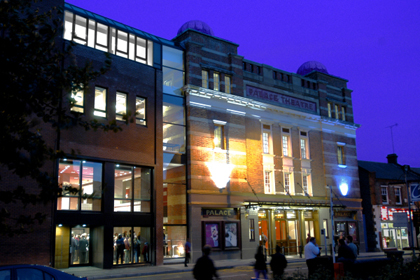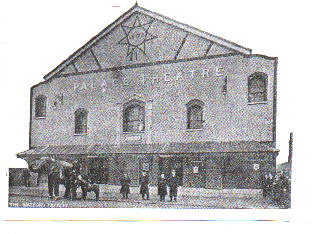
|
PALACE
THEATRE WATFORD
 Note the elephant in the foreground! The Watford Palace Theatre of Varieties* was opened in December 1908. Music Hall was the main fare with an annual pantomime. The many famous artistes who appeared during this era included:  Charlie Chaplin*
George Robey Little Tich The Seymour Hicks Company Stan Laurel* Fred Karno's Company Marie Lloyd Dan Leno* The building itself has
undergone many changes from the basic Music Hall
shell that it originally was. Indeed it was not
until 1964 that the present box office was
actually inside the building!
It was during the First
World War that plays were first produced at
the Palace. Companies were formed by Herbert
Shelley, Kenneth Duffield and Henry Baynton.
In 1932 the theatre produced proper
repertory under the direction of Alfred
Danville. Famous names that appeared during
the 20's and 30's included Bob Hope*, Gracie
Fields, Anton Dolin, Wendy Toye, Ian
Fleming* and Helen Vayne*. Weekly rep
continued throughout the war period with
companies formed by Andrew Melville and
Jimmy Perry.
[ *Note: The
information above was published by the
Palace Theatre in 1981 in the souvenir
programme "The Importance of Being
Earnest" celebrating reopening following
refurbishment. According to Mr Ian
Scleater, the Palace's current
Archivist, the following claims are
inaccurate or questionable:
The theatre never operated under the title “Watford Palace Theatre of Varieties”. There is evidence that it was intended to be styled “Palace of Varieties” but one week before opening on the 14th December 1908 the name was changed to “Palace Theatre”. The reason for this change is not apparent but it is probable that the builders built the wrong name in raised brickwork into the façade of the original building. Charlie Chaplin and Stan Laurel never appeared at the Palace Theatre. They were both members of Fred Karno’s Company of Comedians and Stan Laurel (who in those days appeared under his real name of Jefferson) was Charlie Chaplin’s understudy. The Karno company came to the Palace on eight occasions but on none of those occasions was either of them in the company. On the other hand Sydney Chaplin, Charlie’s elder brother and more well known of the two at that time and also a member of the Fred Karno company, did appear. Similarly Bob Hope did not appear at the Palace. Dan Leno died four years before the theatre was built but his son Dan Leno junior did come to the Palace in 1923. I have no record of appearances by Ian Fleming or Helen Vayne] Many popular plays were
performed during this period and it is with
much affection that Watford people still
talk about this era in the theatre's history
A major change took place in the theatre's
financial situation in 1960 when for the
first time it received any form of subsidy A
generous grant of £4500 was provided by
Watford Corporation and further assistance
was forthcoming on an annual basis until
1964 when Jimmy Perry approached the
Corporation with the idea of transferring
the theatre lease into civic hands; The
Corporation readily agreed, undertook the
management of the theatre, and formed the
Watford Civic Theatre Trust Ltd.
Artistic Directors during this last part of the theatre's history have gradually increased the length of run of the productions and the standards of performance have risen considerably. Many new plays and classics have been produced and have attracted a wealth of well-known artistes. The theatre has gained national acclaim and has transferred a number of productions to London's West End. Memorable are 'Don Juan', 'The Ballad of the False Barman', 'The Letter', 'The Hostage', 'Alpha Beta', 'The Corn is Green', 'Happy as a Sandbag', 'Leave Him to Heaven', 'Out on the Lawn', 'Cabaret', 'The Girl in Melanie Klein' Giles Havergal was the Civic Theatre Trust's first Director. He was followed by Kay Gardner and Stephen Hollis, who was responsible for many of the Palace's successes in the 70's. In 1980 Michael Attenborough was appointed Artistic Director. Later Artistic Directors include Lou Stein, Leon Rubin, Giles Croft, Lawrence Till and Brigid Larmour. As mentioned above, the theatre building has undergone many changes, the most satisfying in your host's opinion culminating in its reopening in 1981 when it was restored to its true Edwardian splendour. The most recent makeover may have improved things back-stage but facilities front of house are now inferior, uncomfortable and decidedly tacky. And even the once glorious auditorium where a dusty neon "sculpture" has replaced the chandelier, formerly the centrepiece of the ceiling, and the walls have been painted in battleship grey, now feels cold and unwelcoming. It's hard to understand how this has been permitted, given the theatre's status as a Grade II listed building. The offending "sculpture" totally out of keeping with its historic surroundings. More details of this theatre can be found here |